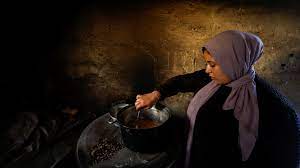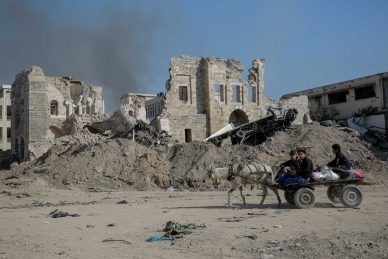The traditional Palestinian woman’s dress known in Arabic as &lsquothobe&rsquo is famed for its skillful stitchery rich colors and patterns featuring stories of each area in historic Palestine. The embroidery is an expression of high civilization and taste boasting of the rich historic culture and prosperity of the fertile land which gave the Palestinians its bounty. After the 1948 occupation of Palestine the intricately embroidered thobe has transcended its role as a symbol of tradition to become an icon of Palestinian identity history and resistance. The 700000 Palestinians who were expelled from their homes by Zionist militias often left their houses with only the clothes on their back.
Fatima Shaet 56 is an owner of traditional embroidery shop in Khan Younis in southern Gaza Strip. She tells me “We still have my grandmother’s thobe which she used to wear in our occupied land.&rdquo According to Fatima “The thobe is so significant as it’s the only remaining thing that proves our right in this land.&rdquo Fatima who prefers to sew her creations by hand rather than using a sewing machine says “It sometimes takes me 8 months or more to make the thobe yet I prefer the handmade embroidery as it is more beautiful.&rdquo She also explains that the embroidery designs on the dresses vary across village and each individual dress is unique unto itself.
The dresses of Jaffa are distinguished by the veins of trees and roses reflecting its beautiful green fields and environment. The Beersheba dress is adorned with a burqa with gold and silver coins on it as Palestinian Bedouin women use it as a form of accessory and simultaneously as protection from the desert sun and sandstorms. Embroidery indicating Jerusalem might include references to stitched crucifixes that indicate the history of the Crusader occupation. Also present might be crescent symbols and Quranic verses indicating for the return of Jerusalem to Islamic rule. Even the colors are dark alluding to sadness from the effects of the Nakba and wars.
Resistance Thobe
After the eruption of the first popular Uprising (Intifada) in 1987 the embroidered thobe became an even more important symbol of defiance and resistance against the occupation’s plot to eliminate the Palestinian history and identity. During the Intifada the Israeli occupation authorities confiscated Palestinian flags and any symbols related to historic Palestine so Palestinian women created the &ldquoIntifada dress&rdquo as a response to the occupation’s ban on public displays of Palestinian nationalism embroidering dresses with Palestinian flags maps and other national symbols. Since then Palestinian women wear them to celebrate national events and happy occasions such as wedding parties graduation ceremonies birthdays and Eid. According to Fatima “The demand for buying the embroidered thobe has been on the rise over the past few years.” She believes that this a direct response to attempts by the occupation authorities to rob Palestinian heritage and use traditional Palestinian symbols for their own.
Systematic robbery
In December 2021 a number of participants in the Miss Universe competition held that year in Israel released pictures on social media platforms while dressed in traditional Palestinian thobe while attributing them to Israeli heritage. The pictures incited an angry public backlash against cultural appropriation amongst Palestinian and pro-Palestine supporters.
The incident is not an isolated one during recent years various Israeli media outlets have published several photos of Israeli models and flight attendants from the Israeli airline El-Al dressed in Palestinian embroidered thobe under the inference that the clothing is traditional Israeli dress.
In response to ongoing systematic theft and erasure of tradition and history Palestinians have initiated thousands of projects to preserve their heritage and to keep reminding and enlightening the young generations of their rights and heritage. Fatima’s embroidery is part of that critical ecosystem of preservation and perseverance a testament to the originality and steadfastness of the Palestinian nation manifested in their culture and traditions.
– Wafa Aludaini is a Gaza-based journalist and activist. She contributed this article to the Palestinian Information Center.














